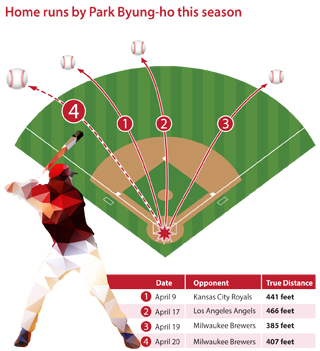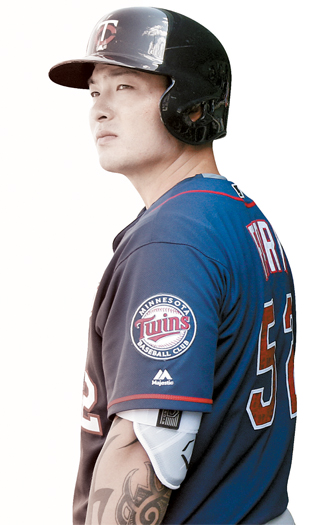Park’s fourth homer another big hit

Park’s four dingers thus far make it apparent that the slugger is adaptive enough to be able to knock almost any type of pitch over the fence.
Park went to the plate on Wednesday as the designated hitter against the Milwaukee Brewers during the Twins home game at Target Field. He went on to hammer a fly ball to the left in the bottom of the eighth inning off a curveball by Brewers’ right-handed reliever Tyler Thornburg.
Park has had two home runs in two days and three in less than a week.
Park’s first dinger this season came on April 9 against Joakim Soria of the Kansas City Royals at Kauffman Stadium. The Royals’ right-handed relief pitcher threw 79-mile-per-hour slider that Park drilled over the left fence. Park’s first hit over the fence recorded 441 feet in true distance, according to ESPN’s Home Run Tracker. The speed off the bat was 108.8 miles per hour according to the same source.
He notched his second homer on April 17 against Los Angeles Angels right-handed pitcher Joe Smith.
The slider by Smith travelled 79 miles per hour and Park made a contact with the pitch to send the ball to the center of Target Field.
It was a mammoth hit by Park that travelled 466 feet in true distance, making it possibly the longest home run ever at the Twins’ home ballpark.
The blast was initially measured 462 feet by the Twins. However, the ESPN Home Run Tracker later reported that the true distance for Park’s home run was 466 feet, topping the previous record set by Jim Thome in 2011 at 464 feet.
It is controversial whether Park’s homer is, in fact, the longest one ever in the Target Field due to the variety in the measurements by different sources, including ESPN’s Home Run Tracker and MLB’s Statcast.
Whatever the ultimate outcome, Park’s hit that day was a blast that the Twins fans haven’t seen in a while. The speed off bat for this homer was also astonishing, measured at 112.9 miles per hour.
After hitting two home runs off sliders, Park decided he would take his chances and give it a go against a fastball.
During the game against the Brewers on Tuesday, Park went head-to-head with the Brewers’ right-hander Chase Anderson in the bottom of the fourth inning. With a 3-1 count, Park knocked Anderson’s 90-mile-per-hour fastball over the right fence of Target Field. The true distance of Tuesday’s homer was 385 feet.

Park Byung-ho
The velocity of Thornburg’s curveball on Wednesday was about 78 miles per hour. But its break, which indicates the amount of bend in the trajectory of a pitch, recorded a tough 14.
The higher the break, the sharper the drop of the curveball and the more difficult it is to hit.
Los Angeles Dodgers ace pitcher Clayton Kershaw, one of the most celebrated pitchers in the MLB today, threw curveballs on April 10 against San Francisco Giants with breaks that ranged from 10 to 16.
“Park is bold on the plate and that leads to the power hits that he is known for,” said Kim Yong-dal, a former professional hitting coach after Park’s third dinger. “Regardless of the trajectory of the pitch, Park can essentially take on anything, whether they travel into or away from his body. I think we are going to see a lot of quality hits from Park in the MLB.”
Park also had another multi-hit game on Wednesday. His season average as of Wednesday stands at .233, going 10-for-43.
The one pitch Park has struggled with has been the four-seam fastball, against which he’s had no hits, 10 fouls and two whiffs.
Though it’s still early, if Park keeps up his current pace, he could set a new record for most home runs hit by an Asian Major Leaguer in a single season.
Among Korean sluggers, it is Texas Rangers’ Choo Shin-soo that has had the most success on the plate, hitting 22 dingers in both 2010 and 2015.
In Asia, it is the retired Japanese outfielder Hideki Matsui, who played for the New York Yankees and the Angels. In his second season with the Yankees in 2004, Matsui collected 31 home runs, making him the only Asian hitter in the history of MLB to card more than 30 home runs in a season.
Park has hit four home runs in 14 games. If he maintains the current tempo, Park could hit as many as 46 this season, although this number seems little far-fetched considering the length of a single season in the MLB (162 games).
Regardless, there’s no doubt that Park, who once was considered one of the best sluggers in the Korea Baseball Organization history, can still snatch powerful hits in the big league. After all, the average true distance of Park’s four home runs is 424.8 feet, far eclipsing the MLB average at 400.6 feet.
The Twins’ projection for Park’s rookie year is 31 home runs and 77 runs batted in while averaging .252 during 481 at-bats.
BY CHOI HYUNG-JO [choi.hyungjo@joongang.co.kr]










with the Korea JoongAng Daily
To write comments, please log in to one of the accounts.
Standards Board Policy (0/250자)